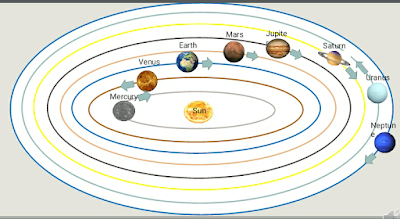The solar system is simply the Sun and its 8 planets revolving around it in an elliptical path. In this tutorial we will get answers of questions like -What is a planet?,What is a natural satellite?, What are the essential conditions required for sustaining life on a planet? and many other such questions related to our solar system and it's planets.
The Sun:-
- It’s size is thirteen times the Earth.
- It’s diameter is 1.4 million kilometres.
- The sun is about 150 million kilometres away from the earth.
- The composition of the Sun:- Hydrogen71% , Helium26.5% and remaining 2.5% consists various metals and elements, including neon, iron, oxygen and carbon.
- The sun continuously gets energy from the fusion of hydrogen to helium releasing huge amount of energy and vice-versa.
- The planet revolve around it at an about the speed of 70000 km per hr.
- It takes around 8 minutes and 20 seconds to reach the sunlight from the sun to the earth at an speed of light that is 300000 KM/seconds.
1. Terrestrial Planets(Inner Planets):-
- The four inner planets which is near to sun (mercury, Venus, Earth and Mars)are terrestrial planets.
- These planets are also called as rocky planets or solid planets.
- These are made up of the denser materials like metals, minerals and rocks.
- They contain few or no satellites.
- They have a thin layer of atmosphere.
2. Jovian Planets (Outer Planets):-
- The four outer planets (Jupiter, Saturn, Uranus and Neptune) are called as Jovian planets.
- They are made up of gases mainly Hydrogen and Helium.
- Some planets have rings around it.
- They have large numbers of natural satellites.
1. Mercury:-
- It is the closest planet to the sun.
- It does not have any protective blanket like ozone on earth to prevent it from harmful radiations.
- Many building blocks of life carbon dioxide, nitrogen, Hydrogen and oxygen.
2. Venus:-
- This planet is nearest planet to the earth and also known as the earth’s twin.
- Venus is known as the Evening Star as well as Morning star.
- Venus is the hottest planet of the Solar system due to a thick blanket of methane which prevents the reflection of incoming radiations of the Sun due to which it is also called as Veiled Planet.
3. The Earth:-
- Earth is the largest planet of the inner planets.
- It takes around 23 hours 56 minutes and 4.09 seconds to rotate on its own axis., while it takes about 365 days 5 hours and 48 minutes to revolve around the Sun.
- It is the only of the solar system that has the ability to sustain life due to presence of water, oxygen, nitrogen etc.
- The is tilted on its axis and makes 66.5°.
4. Mars:-
- Mars is known as Red Planet due to presence of iron rich red soil and pinkish atmosphere of it.
- Phoebes and Demos are only two satellites of Mars.
5. Jupiter:-
The Moon:-
- This the largest planet of solar system.
- Also the largest satellite of solar system is the Jupiter’s satellite Ganymede.
- The average temperature of Jupiter is very low (-148 degree Celsius.
- It is the fifth planet from the sun and average distance from the sun is 772.8 million kilometres.
- It is the 2nd largest planet of the solar system.
- Saturn has bright concentric rings, It is made up of ice and dust particles.
- It’s largest satellite is Titan.
- It was discovered by Sir William Hersiel.
- Uranus and Venus are the only planets which rotates from east to west on its axis. which is opposite to other.
- It is seventh planet from the Sun and it is also the third largest planet of the solar system.
- It appears greenish in colour since it has methane gas in present in its atmosphere.
- It is also called as “Planet on its Side”.
- It is the fourth largest planet of the solar system and 47 times bigger than the Earth.
- Neptune and Uranus is known as twins because of similarities.
- It has 8 natural satellites.
- Pluto is not considered as Planets from 24th August 2004 as declared by IAU(International Astronomical Union).
- Earlier Pluto was discovered by Clyde Tombaugh in 1930.
- Now Pluto is an asteroid and numbered as 134340.
- It is newly identified planet of solar system.
- But it is not yet proved and officially declared by IAU.
The Moon:-
- The moon is the only satellite of the earth, it takes 27 days, 7 hours and 43 minutes to rotate on its axis(This is also known as sideral month and moon’s period.
- The moon’s period of revolution with reference to the sun is about 29 days, 12 hours, 44 minutes and 2.8 seconds. This period is called a synodic month.
- The bright part of the moon is full of mountains whereas the dark spots are low lying plains.
- Liebuity mountain is the highest mountain of the moon that is 10600 meter high.
- The light of the moon takes 1.3 seconds to reach the Earth.
- Moon is known as fossil planet and it’s study is known as Selenology.
- The gravitational force on the surface of the moon is 1/6 the gravitational force on the Earth.
- The minimum distance between the moon and Earth is 3,64,000(perigee) and maximum distance is 4,06,000 km(apogee).
If you want to download this chapter in PDF format than like or share our post below: -
